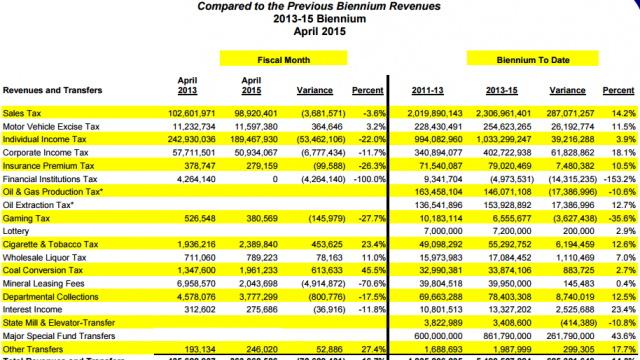North Dakota General Fund Tax Revenues Down 16.7 Percent In April

Oil prices have fallen, and oil activity in North Dakota has slowed down. This is showing up in the state in all sorts of ways from declines in airline boardings to projected falls in enrollment for oil patch schools.
It is starting to show up in the state’s tax revenue streams too per the Office of Management and Budget’s monthly revenue report (see below). For the first time since oil prices took a tumble in December our state’s monthly general fund tax revenues failed to surpass the previous month’s total.
Overall the 2013-2015 biennium is still showing substantial growth. Total general fund revenues to date are up 14.3 percent compared to the 2011-2013 biennium which, in turn, was up more than 62 percent over the 2009-2011 biennium. This chart shows the state’s revenue trend to date for the current biennium compared to the three previous, and “robust” doesn’t even begin to describe this growth:
But a month-to-month comparison shows declines for some of the state’s major tax revenue streams.
Sales tax revenues are down $3.6 million compared to April 2013. Personal income tax collections are down 22 percent, while corporate income tax collections are down 11 percent.
In total, general fund revenues for the state in April of 2015 were down almost 17 percent compared to April of 2013. That’s the first time this has happened since oil prices fell as this chart shows. And keep in mind, direct taxes on oil activity have very little to do with this. The cap for oil tax revenues flowing into the general fund is $300 million per biennium which was met for this biennium long ago. The declines we’re seeing are now are primarily from the income taxes and the sales tax.
Meaning this isn’t just a slow down for oil but a slow down for our entire state economy.
That’s like a sign of things to come. The boom in tax revenues in the 2011-2013 biennium, and most of the 2013-2015 biennium (which ends on June 30) is not the new normal. The current biennium will likely end showing a double-digit revenue increase over the previous biennium, but barring a return to higher oil prices and a resumption of drilling out west we can likely expect the 2015-2017 biennium to start off with steady declines in revenues.
Which isn’t to say that the sky is falling. Even with declines the state will likely take in far more revenue than it did just a few years ago. But certainly the spend-happy era of the last couple of years, where there seemed to be no spending state leaders would say “no” to, is definitively over.






